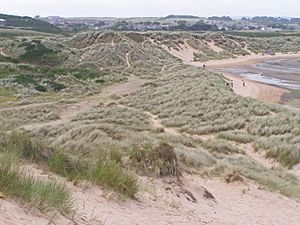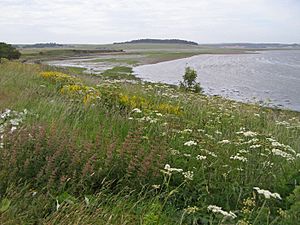Ythan Estuary facts for kids
Quick facts for kids
Designations
|
|
| Official name: Ythan Estuary & Meikle Loch | |
| Designated: | 30 March 1998 |
|---|---|
| Reference #: | 939 |
The Ythan Estuary is where the River Ythan meets the North Sea. It's about 19 kilometers (12 miles) north of Aberdeen, Scotland. Here, the river's water mixes with the ocean's tides. The ocean's tides reach about 7 kilometers (4.3 miles) inland. The estuary is between 250 meters (820 feet) and 780 meters (2,560 feet) wide.
Besides the main tidal channel, you'll find mudflats, sandy beaches, and shingle flats. Some salt marsh areas are also present, especially near the Waterside Bridge and the mouth of the Tarty Burn. This estuary is very important because it has the most significant coastal moorland in the northern United Kingdom.
The Ythan Estuary is a special place called a Site of Special Scientific Interest (SSSI). It's also listed as a Ramsar site (number 939) along with Meikle Loch. This means it's recognized as a wetland that is important around the world.
Many birds call this place home. About 50 pairs of common shelducks breed here. There's also a large colony of terns on the east shore, about 1 kilometer (3,300 feet) from the mouth. These include Arctic, Sandwich, little, and common terns.
You can enjoy many activities here, like birdwatching, fishing, canoeing, and wildfowling. There are special hides where you can watch wading birds, especially when the tide is low. If you want to fish for estuary fish like flounder, it's free. However, please don't disturb the birds during their breeding season. Fishing for salmon and sea trout requires a special permit.
Contents
Exploring the Ythan Estuary's Landscape
North of the estuary's mouth, you'll find the Sands of Forvie. This is one of the largest sand dune areas in Europe. People lived here as far back as the Stone Age. Some dunes north of the estuary are about 80 meters (260 feet) tall. South of the estuary, the dunes are around 50 meters (160 feet) high.
As you go inland from the mouth, you'll first see sandy beaches. Then, you'll find shingle beaches and mudflats. Further up, near the first bridge (about 1,300 meters or 4,300 feet from the mouth), there are mussel beds and marshy areas.
At its widest point, the Ythan Estuary is about 780 meters (2,560 feet) wide. The edges of the upper parts have large mudflats, marshes, and fens. Even further upstream, there's a small island called Geck Island. It's a safe place for cormorants. The land around the Ythan near the coast is mostly flat farmland, with very few trees. Long ago, during the Ice Age, the Ythan River would have been a powerful stream of meltwater flowing from the Scottish Highlands.
Ancient Discoveries at Ythan
People lived in coastal estuaries along Scotland's northeast coast a very long time ago. This includes the Ythan Estuary and the nearby River Don Estuary. Studies show that stone tools found here are at least 9,000 years old (from 7000 BC). Most of these tools from the Ythan mouth area come from the Sands of Forvie.
Many stone tools were found between 1994 and 2001 in this active dune system. Digging deeper, archaeologists found old land surfaces with layers that showed signs of ancient campfires and other tools from the mesolithic period (Middle Stone Age). While no Viking items have been found here, a few kilometers north, at Cruden Bay, there's a place name linked to Viking landings.
Wildlife and Habitats of the Ythan Estuary

The Ythan Estuary is home to many different habitats. These include marshes, coastal areas, estuarine areas, lake-like areas, and sand dunes. This mix of habitats means you can find an amazing variety of plants and animals here. The estuary itself is affected by the tides and is located seven kilometers (4.3 miles) from the North Sea.
The tern colonies are a special sight. Several different species of terns use the north banks of the Ythan Estuary. They make up a large percentage of the breeding terns in the United Kingdom. In summer, you can watch terns diving for food about 600 to 900 meters (2,000 to 3,000 feet) inland from the estuary.
Near the river mouth, you might see birds like scaup, long-tailed duck, red-breasted merganser, and velvet scoter. Sometimes, you can also spot guillemots and razorbills at the entrance to the North Sea.
About three kilometers (1.9 miles) from the estuary mouth, there are huge mussel beds. These mussels are a food source for birds like common eiders (and sometimes a king eider), oystercatchers, and turnstones. On the Forvie Moor part of the Ythan Estuary, you can find both mute and whooper swans. Meikle Loch is also part of the Ythan Estuary area. It has some water plants and is home to many wading birds, ducks, and geese from November to March.
Why the Ythan Estuary is Protected
The Ythan Estuary is a very important place for nature. It's protected as a Special Protection Area (SPA) because it supports many important bird populations in Europe. The protected areas include the estuary itself, the dunes to the east (known as the Sands of Forvie), Meikle Loch, and the nearby Kippet Hills. The Ythan Estuary became an SPA on March 30, 1998. Its special code is UK9002221.
During the breeding season, the Ythan Estuary is vital for these bird populations:
- Common tern (Sterna hirundo): About 265 pairs breed here. This is up to 2.2% of all common terns breeding in Great Britain.
- Little tern (Sterna albifrons): About 41 pairs breed here. This is up to 1.7% of all little terns breeding in Great Britain.
- Sandwich tern (Sterna sandvicensis): About 600 pairs breed here. This is up to 4.3% of all Sandwich terns breeding in Great Britain.
The Ythan Estuary is also important for birds that migrate here in winter. It supports a significant population of:
- Pink-footed goose (Anser brachyrhynchus): About 7,213 individual geese spend the winter here. This is up to 7.7% of the total population that winters in Eastern Greenland, Iceland, and the United Kingdom.



